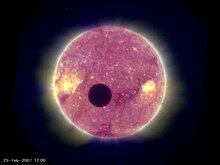Passage
A passage or passage is an astronomical event :
- In general, the apparent meeting of two astronomical objects , e.g. B. the passage of the perihelion of the planet XY (point closest to the sun), the passage of the moon through the meridian plane or of a star through the first vertical .
The following passages are specifically designated as transit :
- The meridian passage : A celestial object crosses the meridian (the south direction at the place of the observer). As a rule, it then reaches the greatest angle of elevation above the horizon . If the declination changes slightly (when the object is close), the highest altitude occurs shortly before or after the meridian passage. For more information → see culmination and astronomical location .
- The transit of two celestial bodies or the partial occultation , which are specifically discussed in this article.
- The passage of a star through the thread network of a measuring telescope, see star passage .
Transit of two celestial bodies

If an apparently smaller celestial body passes in front of another and partially covers it, this passage is called a transit. The size ratio is determined by the apparent size . In the opposite case - with a possibly complete covering of an apparently smaller celestial body - one speaks of occultation .
The transit is a special case of conjunction .
The following constellations are possible:
- When the planets pass, one of the lower planets ( Mercury or Venus) passes in front of the sun .
- A planet with a smaller angular diameter passes in front of a planet with a larger angular diameter
- A moon (Trabant) of a planet passes in front of this planet
- An asteroid or comet passes in front of the sun ( see: asteroid passage )
- An artificial satellite (e.g. the ISS) passes in front of the sun or moon
- A double star passage (eclipsing stars )
- A passage of an exoplanet in front of its central star (see transit method )
- Note: A solar eclipse is not referred to as a transit, but as a special case of occultation. However, a ring-shaped solar eclipse corresponds phenomenologically to a transit because the moon has a smaller angular diameter than the sun
For a passage of a lower planet in front of the sun it is necessary that the lower conjunction (planet between sun and earth) coincides with the node (point of intersection of the orbital plane with the ecliptic ).
The time and duration of the passage always depend on the observation position .
Passages of artificial earth satellites
Even artificial earth satellites may fall into the line of sight between an observer on Earth and the sun or the moon. However, such events are difficult to observe because the visibility strip is only a few kilometers wide. Nevertheless, transits of the International Space Station ISS in front of the sun and moon have often been observed and photographed. The satellite usually wanders in front of the sun for 0.5–2 seconds. As with a planetary passage, no visual decrease in brightness can be registered subjectively .
See also
literature
- Zimmermann / Weigert: Lexicon of Astronomy , Spectrum Academic Publishing House, 1999
- Marco Peuschel: Conjunctions, coverings and transits - The little almanac of the planets . Self publication . Engelsdorfer Verlag, Leipzig 2006, ISBN 3-939144-66-5


